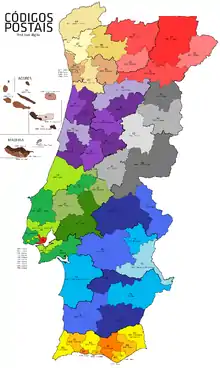Postal codes in Portugal
The Portuguese postal code (código postal) is formed by four digits, a hyphen, then three digits, followed by a postal location of up to 25 characters in capitals.
Avenida Marconi 4C
1000-260 Lisboa[1]
Postal codes are given at the building block level and also to designated addresses with high volumes of mail. The first digit designates one of nine postal regions; the following two digits designate postal distribution centers; the fourth digit is 0 if it belongs to a capital of municipality, 5 if not, or any other digit if it is a designated address; the last three digits sort building blocks and designated addresses. The more important the city, the more rounded is the number formed by the first four digits.
Previous formats
Prior to 1976, only Lisbon had used a system, of six zones (Lisboa 1 to Lisboa 6).
Avenida Padre Manuel da Nobrega 14, 2º Esq.
Lisboa 1[2]
In 1976, a national postal code system was introduced, with a four-digit structure, and designated addresses added "CODEX" (abbreviation of código extraordinário) to the postal location:
Instituto de Hidráulicas e Recursos Hídricos
Rua dos Bragas
4099 Porto CODEX[3]
In 1994, three extra digits were introduced and the "codex" expression was dropped.
Postal regions

Postal regions (first digit of postal code):[4]
- (red) - City of Lisbon
- (green) - Estremadura e Ribatejo: Lisbon metropolitan area (except City of Lisbon), Santarém District and parts of Leiria District
- (purple) - Beira Litoral: Coimbra and Aveiro districts and part of Leira and Viseu districts
- (cream) - Minho e Douro Litoral: Viana do Castelo, Braga District and Porto District and part of Viseu and Vila Real Districts
- (pink) - Trás-os-Montes e Alto Douro: Bragança District, most of Vila Real District and northern parts of Viseu District and Guarda District
- (grey) - Beira Interior: Castelo Branco District and Guarda District and northern tip of Portalegre District
- (blue) - Alentejo: Beja District and Évora District and parts of Portalegre District and Setúbal District
- (yellow) - Algarve: Faro District
- (brown) - Madeira Islands and Azores
Note that, although the regions' names are connected to the (extinct) provinces of Portugal of 1936, their limits (with the exception of Algarve) are not exactly the same.
People can also search for postal codes at the CTT Correios website.
Postal codes for main cities
Lisbon: 1000, 1050, 1070, 1100, 1150, 1170, 1200, 1250, 1300,1500 1350, 1400, 1500, 1600, 1700, 1750, 1800, 1885, 1900, 1950 and 1990
Porto: 4000, 4050, 4100, 4150, 4200, 4250, 4300 and 4350
Aveiro: 3800 and 3810
Beja: 7800
Braga: 4700, 4705, 4710 and 4715
Bragança: 5300
Castelo Branco: 6000
Coimbra: 3000, 3020, 3025, 3030, 3040 and 3045
Évora: 7000 and 7005
Faro: 8000 and 8005
Funchal: 9000, 9020, 9030 and 9050
Guarda: 6300
Leiria: 2400, 2405, 2410, 2415 and 2420
Ponta Delgada: 9500
Portalegre: 7300
Santarém: 2000 and 2005
Setúbal: 2900 and 2910
Viana do Castelo: 4900
Vila Real: 5000
Viseu: 3500, 3505, 3510 and 3515
See also
- List of postal codes in Portugal
References
- Av. Marconi 4C, 1000-260 Lisboa, Portugal, Google Maps
- Tenth International Congress of Photogrammetry, Lisboa, Portugal September 7-19, 1964: Executive & formal meetings, resolutions, etc, A. Paes Clemente, Board of the Xth International Congress of Photogrammetry, 1972, page 248
- History and Heritage of Coastal Engineering, Nicholas C. Kraus, ASCE Publications, 1996, page 413
- "Post Code Search". CTT. Retrieved 2008-05-04.
External links
- Search for Postal Code from CTT Website